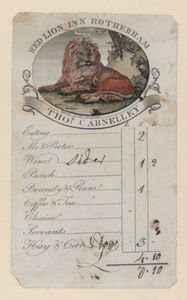Advertisement

 A "bar bill"
A "bar bill"
Something that very likely would get thrown away. I'm sure glad it didn't though.I signed up to visit the Social Sciences library available to Oxford University's students in the morning. This is the closest thing I have seen to the public libraries where I have been working in San Diego. The Social Sciences library is user friendly, unlike the Bodleian which was built to impress people not really to be comfortable. Also, this library has the most usable computer databases and terminals. Not only are there outlets for computers and internet cables at every single study space in this library, but there are closed-off study areas only for graduate students in special rooms (with comfy chairs). Stalls were designed for students who need to really isolate themselves from distractions and everything from ethernet cables to USB drives are available for sale in the little store.
The books are organized by Library of Congress classification, but there is definitely a different system at work here. A large number of the books on the shelf have a little yellow sticker that warns that it is reference book only and not available for check out. Little slips of paper are available at the end of each row so that once you remove one of these books,

 juvenile ephemera
juvenile ephemera
which includes this game for childrenyou can write down your table number and name. If someone goes looking for the book, you are supposed to leave the slip of paper where the book was so that they can find you and request to read it after you. A similar system is used at the Radcliffe Camera and other libraries we have seen.
The most impressive part of the Social Sciences library was easily the demonstration of the databases and other online resources available to the students. Along with the expected databases from EBSCO and GALE, the website had a specialized/cusomized google search for the students. A deomstration showed how special websites were chosen that contained only raw data that could be used in Social Sciences projects. For some websites, the entire site was used, and for others a specific URL limited the search to only that page.
The John Johnson ephemera collection was a new sort of special collection for many of us. The definition we were given for ephemera, which I rather liked, was "items that are not supposed to survive their immediate purpose." Tickets, cards, forms, bookplates and innumerable other items are included in this umbrella-like term. My anti-packrat tendencies made me crinkle my nose at the thought of boxes upon boxes of junk that was intended to be thrown away. But when I was able to see some of the items, my heart quickened with excitement. Fliers from parties that happened in the 1800's were flattened out, emblazened with colorful images of days many years past. Postcards for sufferage (and, shockingly, anti-sufferage women!) showed clever cartoons or serious artistic propaganda. Posters and advertisements and, be still my beating heart, VALENTINES! Gorgeous, old-fashioned, hand-cut, romantic Valentines. As we walked through the display, I saw an entire box with this label on it.
The current project being undertaken by the John Johnson Collection is not an uncommon one. Having such rare and unusual artifacts, they are slowly but surely transferring their hard copies to electronic format. I couldn't help but be impressed with the amount of detail that is put into each and every item. Besides the data entry involved (to enable searching by keyword, a huge amount of data must be hand typed into the entries), the image quality is drool-worthy. In order to get up close and personal, a user is able to zoom in very closely and move the zoom around with a coordinating drag-able box. It feels like looking at the image through a magnifying glass, only you can also pick up a drag-able, transparent ruler to measure the image against real-life measurements. The online archive is currently available through ProQuest. I was excited to learn that the mainstream database provider has picked up this project because it is very likely that the John Johnson collection will soon be available to the United States (providing that either my public library or the university I attend will purchase a subscription that includes access). All in all, very exciting.
Advertisement
Tot: 0.125s; Tpl: 0.009s; cc: 5; qc: 44; dbt: 0.046s; 1; m:domysql w:travelblog (10.17.0.13); sld: 1;
; mem: 1.1mb

 A "bar bill"
A "bar bill"
 juvenile ephemera
juvenile ephemera